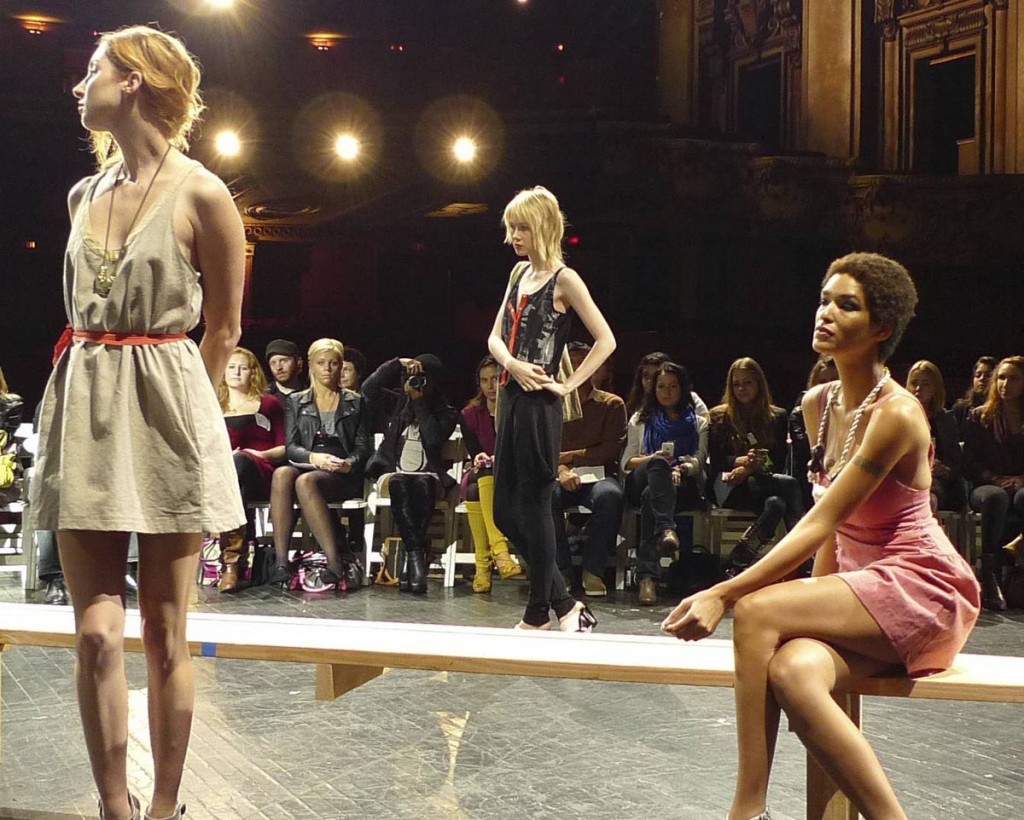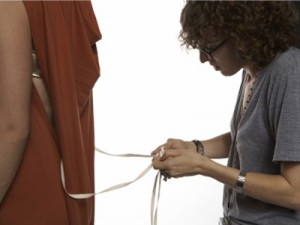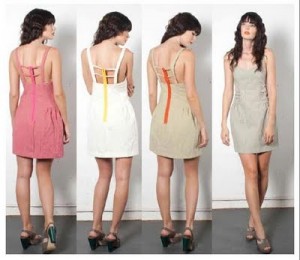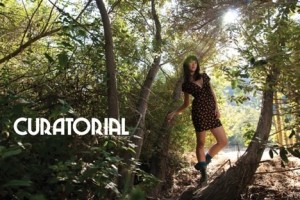
This recession has got me thinking. When you’re broke and you have a tiny apartment, you don’t have a lot of room (literally) to make offensive choices in fashion, or to buy things that you won’t love to death. That’s why lately I’ve been attracted to artists who think just as hard about creating your closet’s favorite “missing piece” as us flea-market tromping, chic-yearning consumers do. Luckily I’ve found the right woman. I first learned about Lizz Wasserman and POPOMOMO (short for Post-Post Modern Movement) at 2009 LA Fashion Week. Sitting in the audience, I watched the designer present her modern, eco-conscious collection as models weaved in and out of a Constructivist-inspired centerpiece. Then I attended her battle at the LA leg of Style Wars (watching her team whip up a tricked-out picnic table dress complete with plastic floral shower curtain and suspender support system). It’s now the next morning and I am following her into a small workroom covered in fabric, racks of POPOMOMO designs and fragments leftover from her recent wedding party held in the studio. The room opens up into a studio where her new-husband (“I’m still trying to figure out what to call him” she laughs) Isaac Resnikoff works as a sculptor. Here at her workstation I sit down with the artist to talk about her mission for environmentally sound fashion, why shoppers should think about their clothes as an investment and what inspires her to be a designer off-the grid.
WM: POPOMOMO seems to focus on the modern woman and in your designs you feature interesting shapes and cutouts, creating an almost architectural feel to your clothes – what inspires you to design the way you do?
 LW: I really like the idea that with a simple drape you can have something that both hides and shows somebody’s form. I want to make sure that if you get a POPOMOMO piece, you are getting something that’s different, everything should always be special and have a reason for being. I feel like a lot of companies are doing these repetitive knits that you already have, you don’t need another one and you definitely don’t need one in inorganic cotton to be wasteful again. So I try to make everything a little special.
LW: I really like the idea that with a simple drape you can have something that both hides and shows somebody’s form. I want to make sure that if you get a POPOMOMO piece, you are getting something that’s different, everything should always be special and have a reason for being. I feel like a lot of companies are doing these repetitive knits that you already have, you don’t need another one and you definitely don’t need one in inorganic cotton to be wasteful again. So I try to make everything a little special.
WM: You can see it’s special, there’s an imagination-factor in the designs I think any woman would want to wear. What does ‘femininity’ to you and how do these elements express your ideas about your female customer?
LW: That’s a really interesting question; I’ve never really thought of femininity – when I was in third grade a shaved my head. It’s been an interesting personal journey being a woman and wearing the things I like, it’s been fun – but “femininity” is kind of a scary word to me.  It’s more about an intellectual and emotional relationship with the clothing. When I think about who my girl is maybe she’s got a red wine stain around her lips because she was out too late at a gallery opening, she’s wearing a sexy but oversized dress and she’s got ripped tights because she rode her bike there. She’s not really thinking about femininity, she’s thinking about herself in a more intellectual and sexual way as opposed to a gendered way.
It’s more about an intellectual and emotional relationship with the clothing. When I think about who my girl is maybe she’s got a red wine stain around her lips because she was out too late at a gallery opening, she’s wearing a sexy but oversized dress and she’s got ripped tights because she rode her bike there. She’s not really thinking about femininity, she’s thinking about herself in a more intellectual and sexual way as opposed to a gendered way.
WM: Like an “I’m a girl dealing with this modern world” kind of femininity.
LW: Exactly, and I’ve rarely asked myself, “Does this look pretty?” I’ve thought, “Does this look cool? Does this look hot or amazing?” “Pretty” doesn’t come up very much.
WM: Tell me a little bit about your new collection, who was the girl you had in mind while designing your Spring 2010 line?
LW: For Spring ’10 I was inspired by the Russian Constructivists and one woman, Liubov Popova, was the only girl among these male avant-garde artists living in Russia. She painted, but as Constructivism became more about functionality and design, a lot of the guys went into graphic design and although she did graphic design she also created set design and clothing. So I think [for this collection] the woman I have in mind has one eye on the outfit, and one on everything else.
WM: So do you have an ultimate icon that you base your work on?
LW: I think it’s always been my girlfriends, their internal beauty and me and sexiness comes from within and when you meet them you can’t help but think, “you are so interesting”. They’re doing these amazing things, they’re always busy, they always look amazing but a little disheveled. We’re always around artists. They’re more fun, they don’t have to get up in the morning [Laughs].
WM: What is it about natural, eco-friendly fashion that you find most intriguing and why is it so important to the POPOMOMO brand?
LW: I think it’s the way it should be. It’s not such a big deal [for companies] to change to eco-friendly practices, it’s more about an industry dragging its feet and lacking technological innovation to reverse that, instead they stay where they’re at because they think their profit margin is at a really good place even though it’s harmful. As far as the nature aspect goes my mom is a landscape architect and my dad is an architect, and I feel like they have always taught me that form and function have to follow. So if you have a garment that’s not socially innovative either in its fabrication or its shape then you’re not making anything new. I don’t understand these young designers using things like rayon, things that really hurt the Earth, it’s not an innovative or modern thing to do.
WM: They say you strive to be the anti-thesis of “disposable fashion”, this idea is so interesting to me, tell me about why you think consumers ought to be more thoughtful in their choices and what makes your line in-disposable?
LW: If it’s rolling off an assembly line and you’re putting it on, that’s not as interesting. I remember when I was working in New York it was the most fun thing to jump out at lunch and come back with five new outfits under $200, but then I realized that if I wasn’t spending that money [on outfits] I could buy a really nice pair of shoes. It is knowing that you can invest in a personally designed object, handmade, in the US – or you could pay a kid in Myanmar a couple cents to wear something until two weeks down the line when you realize you really don’t need it anymore. With POPOMOMO, it’s an interesting question with growth because I’ve been saying to myself, “I need to grow, I need to become a bigger line”. But at the same time I look at the lookbooks of these young designers that have forty-five looks and I just don’t want to be there because I don’t think people need to integrate forty-five looks into their wardrobes. Every season I’m trying to get it down to ten to twenty things that you can imagine wearing all through the season and into the next, bringing it back again in a million different ways.
Lizz Wasserman has a new project in the works, CURATORIAL by POPOMOMO which takes dead stock, handpicked vintage fabric and turns it into contemporary, forward-thinking new designs.  These pieces are one-of-a-kind and a spearhead initiative of anti-waste, but surprisingly affordable. Lizz has definitely inspired me to give my closet a second look, and the next time I’m thinking about “expanding” I’ll consider her call to abandon my passive shopper ways.
These pieces are one-of-a-kind and a spearhead initiative of anti-waste, but surprisingly affordable. Lizz has definitely inspired me to give my closet a second look, and the next time I’m thinking about “expanding” I’ll consider her call to abandon my passive shopper ways.
To learn more about POPOMOMO visit www.popomomo.com

Awesome article! Her Curatorial line sounds amazing and I love what she’s doing with reusable fabrics, thanks for letting me know!
:)